佛學與資訊的發展
杜正民 老師 提供
網路資訊室 整理

一、歷史背景及沿革
中華佛學研究所於1998年2月特別成立了佛學網路資料室 Buddhist Studies Information Network Center(簡稱為網資室), 以因應網路的蓬勃發展、數位化文獻資料、出版品電子化、資訊共享等新世紀的趨勢,並逐步建立起較完整的「數位佛學參考資料庫」(Buddhist Digital Reference Databases)。
(一) 1998年2月15日協辦中華電子佛典協會(CBETA)
1998年2月15日由「北美印順導師基金會」與「中華佛學研究所」贊助成立「中華電子佛典協會」(Chinese Buddhist Electronic Text Association, 簡稱 CBETA),其目的為免費提供電子佛典資料庫以供各界作非營利性使用。此電子佛典資料庫第一期是以《大正新脩大藏經》(大藏出版株式會社c)第一卷至第八十五卷、《卍新纂續藏經》(株式會社國書刊行會 ©)第一卷至第九十卷為底本,並正式取得該底本版權者「大藏出版株式會社」及「株式會社國書刊行會」輸入與公開之授權。
(二) 1999年10月 與台大簽訂「佛學數位圖書館暨博物館」經營合約
在1999年10月,創辦人聖嚴法師與國立台灣大學陳維昭校長簽定「佛學數位圖書館暨博物館」經營合作契約,由本所網資室負責「佛學數位圖書館暨博物館」的資料蒐集、組織與數位化等工作。「佛學數位圖書館暨博物館」的前身為台大釋恆清教授於1994年所創建的「佛學網路資料庫」,該資料庫自1994年起至2003年已經完成的佛學書目資料約計10萬筆,建置中英文學術論文全文資料庫有4000篇左右,以及「佛學網路梵文、巴利文、藏文佛典語言教學」、「佛學網站資源」(Buddhist Internet Resource)、「佛教工具」等資料庫提供學界檢索應用。此項計畫目前由台大圖書館負責,正蓬勃發展中。這座擁有中、英、日書目超過十萬筆的網路圖書館,目前已是全世界最大的電子華文佛學資料庫,也是全球佛學研究者最重要的查詢路徑之一。
二、 2002年3月結合圖書館提昇為「圖書資訊館」
2001年中華佛學研究所從北投搬到金山鄉,圖書館歷經三次搬遷,同時結合資訊網路科技,將原先以紙本為主的傳統圖書館,結合網資室提昇為「圖書資訊館」,於2002年3月6日下午,在佛研所創辦人聖嚴師父、悟明長老及今能長老共同剪綵下,正式啟用。此舉整合了傳統紙本圖書與網路科技,將傳統書本圖書減少,增加資訊化圖書,除了功能完備外,更具前瞻性。期許圖書資訊館能成為全台灣,甚至是全球佛學資訊的重要寶庫,同時藉此為台灣佛學研究扎根。故圖書資訊館館藏除了包含當代漢文、梵文、巴利文寫就的五十一套不同文本的紙本藏經外,還闢設專區,收藏超過兩百五十多年歷史的緬甸寫本貝葉等珍貴文獻,並且在編目數位化後製成光碟,上網流通,方便國內外學者使用。可以說圖資館的最大特色,即為大量電子佛典與數位佛學文獻的製作,與強調網路資訊的整合運用,讓讀者可同時檢索圖書與數位資料,此為實體與虛擬的結合,也是傳統圖書館與電子圖書館的結合。如此符合現代化、國際觀的建館目標,獲得與會者的認同,香光尼眾佛學院自衍法師即指出,圖書資訊館的創設是「締造專業佛學圖書館的高峰」,也更向服務對象擴及全球而邁進。

聖嚴法師、悟明長老及今能長老共同剪綵。
Opening of the Library and Information Center.
除了推動館內典藏數位化,佛研所圖資館並且十分注重資訊經驗的分享、交流,不斷地將本身的電子化技術與心得向外推展,積極扮演著國內佛教資料數位化的「火車頭」。最具體的例子為與台灣大學共同合作的「佛學數位圖書館暨博物館」網站。這座擁有中、英、日書目超過十萬筆的網路圖書館,目前已是全世界最大的電子華文佛學資料庫,也是全球佛學研究者最重要的查詢路徑之一。另外,由法鼓文化所出版,收錄聖嚴師父著作等身一百冊的《法鼓全集》套書,也在圖資館的協助下,推出光碟版。
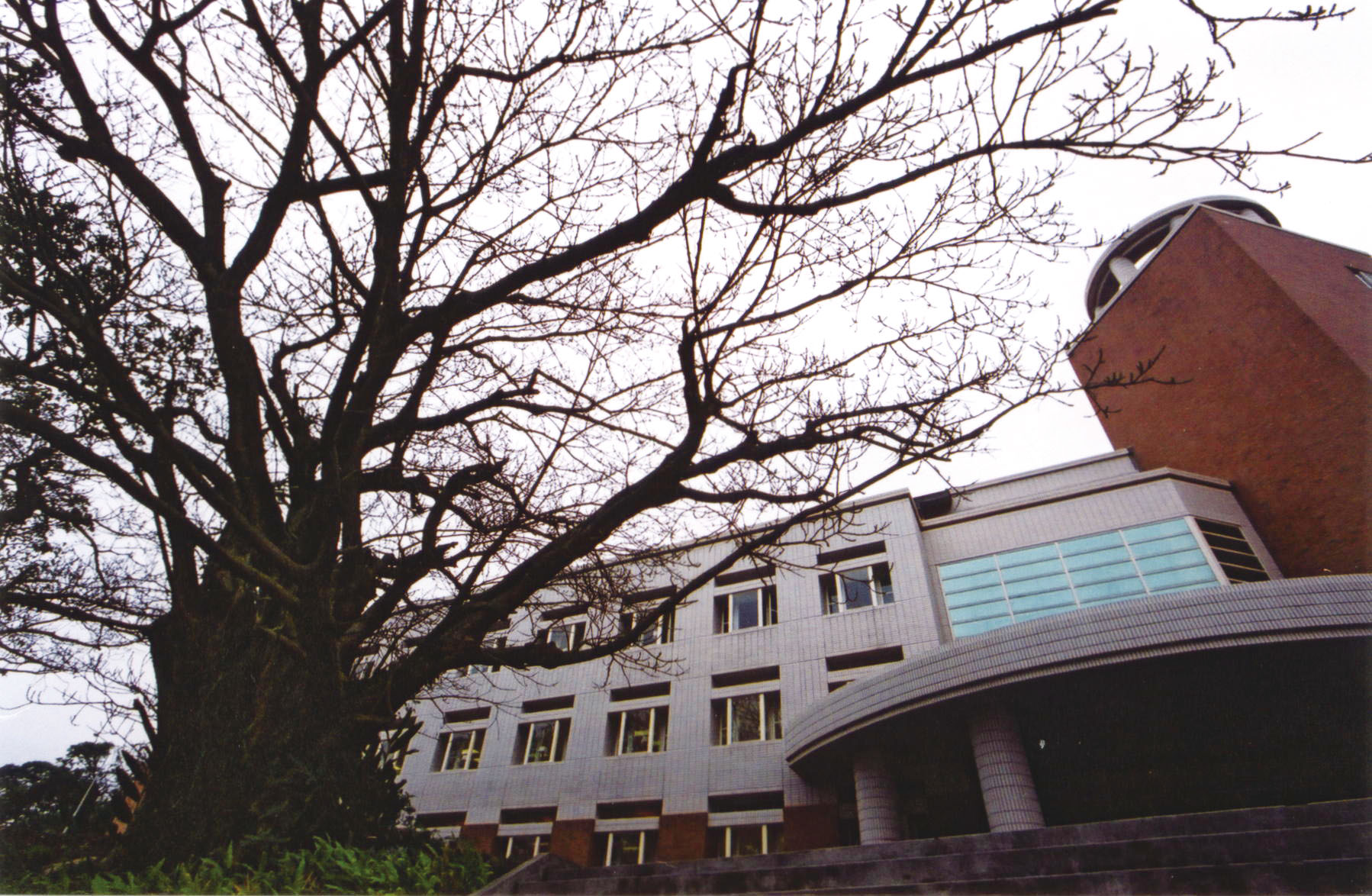
與大自然融成一片的圖書資訊館。
Campus in harmony with Nature.
圖資館的豐富資訊經驗得力於資訊部門「網資室」,從杜正民館長到「網資室」的工作人員,先後都曾參與過國內最大型電子佛典計畫─《大正藏》數位化。這項具開創性且高達百萬字的佛典電子化工作,讓所有的參與者皆獲得了十分寶貴的經驗。由於有了這些先前的經驗,使得圖資館從發展一開始就減少了很多摸索的路程,加快了發展腳步。
近年來,台灣與國際間佛教界、學界交流日益頻繁,為數不少的專家、學者前來台灣,就佛研所而言,每年都有來自國外的客座教授,而作為推動學術研究重要後盾的圖資館,一直深受關注,許多訪台的佛教專家學者將到館參訪列為重要的一站。
在眾所注目的關心中,圖資館結合的傳統經驗和與時代同步的科技,於法鼓山絕佳的天然景色中,描繪出一處最獨特的人文景緻,並且如同創辦人聖嚴師父所形容的「學生會一期一期畢業,圖書館卻永不畢業」,透過它,一代、一代的學子,將不斷地從中汲取佛法的浩瀚智慧法水。
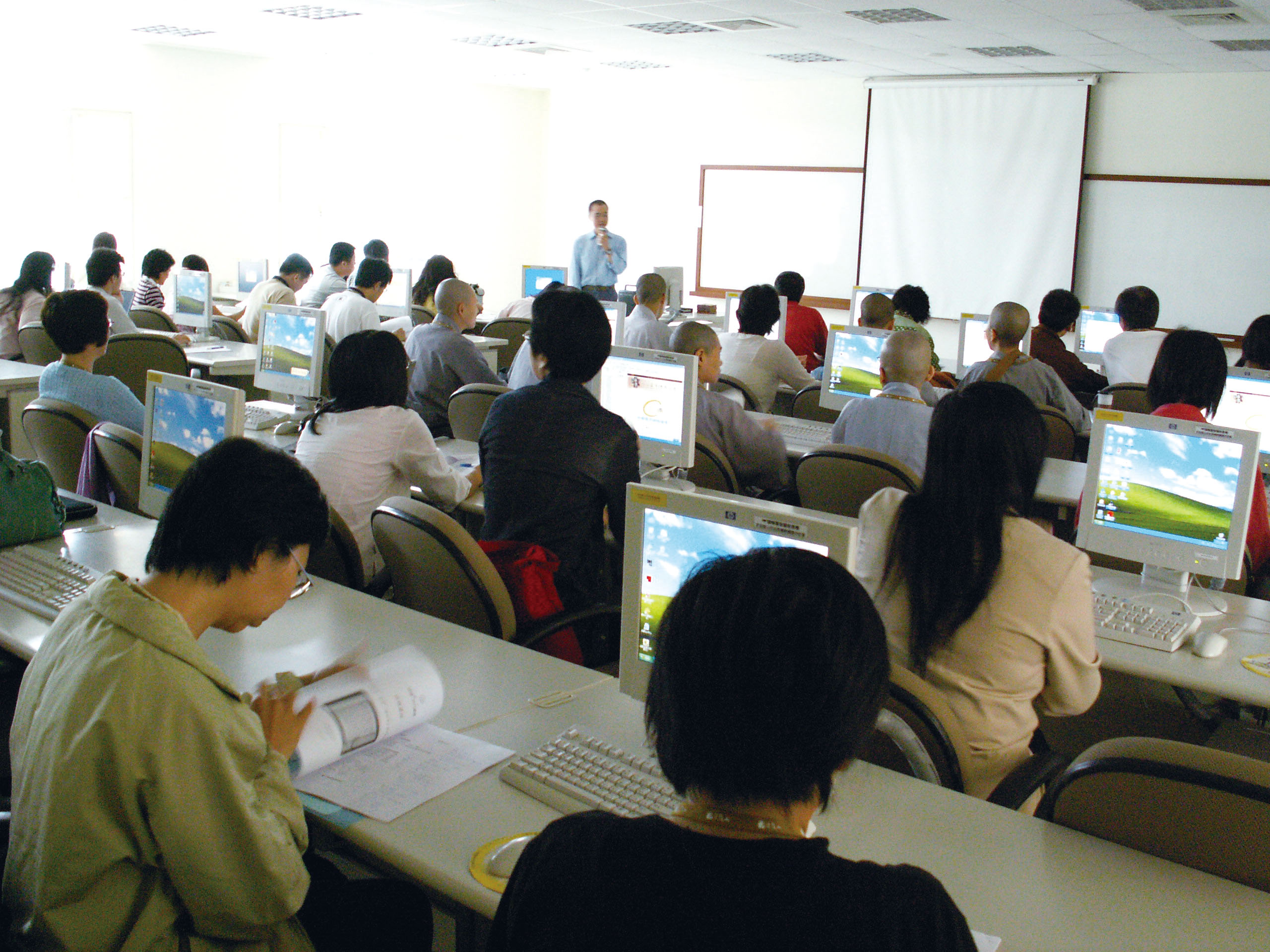
佛學資訊學程。
Computer Lab.
三、 2003年佛學與資訊的整合成立「佛學資訊學程」
「佛學資訊學程」緣起與創設
邁入數位新時代,人文學科必須結合科技新知的研究方式,已是現代學術發展的重要一環,為了因應資訊時代需求,法鼓山中華佛學研究所緊跟世界學術發展潮流,近年來積極規畫開設「佛學資訊學程」以培養兼具佛學與資訊知能之人才,運用資訊科技的媒體與工具,以有效管理資料文獻,改進佛教的教學、研究、服務、行政等各個層面。
此舉首開國內外佛學教育風氣之先,更為佛教打造終身學習環境寫下嶄新的一頁,此將使學生的學習領域更為多元,以及推動嶄新的佛法傳播型式。
「佛學資訊學程」於2006年獲教育部准予於2006年獲教育部准予2006年獲教育部准予成立「佛教資訊組」
配合時代發展,為培養具備資訊素養與資訊能力的宗教師,故設立本組,培訓具數位化能力的宗教人才,參與各項電子佛典作業,以及建構佛教數位典藏。同時,培植具備規劃資訊發展胸襟的宗教人才,以作為資訊時代的弘法師,或佛教資訊學術研究人才。更重要的,為長期教育規劃培養具佛學資訊能力的師資,故設立本組,培訓可至各佛教單位擔任佛教資訊宗教師,或擔任各宗教學院相關資訊課程的教師,甚或在各大專院校教授相關課程。以達本校「培養理論與實踐並重、傳統與創新融合、具有國際宏觀視野的宗教師暨學術文化兩者兼具的人才」的宗旨。
四、結論
自1998年2月成立網資室至今,不斷致力各項e-Project研究,也將眼光放眼國際,充分應用科技整合的優勢,建立功能完備的佛學研究資料庫,圖書資訊館結合網資室、CBETA等單位,建構成教學、研究、行政三環結合的知識神經網路。未來更因應法鼓佛教學院e化需求,協助架設網站及其架構圖及相關e化作業。
佛學資料庫
【電子佛典】
中華電子佛典協會資料庫(CBETA)
網址:http://www.cbeta.org
線上索尋: http://dev.ddbc.edu.tw/concordance/
特色:《大正新脩大藏經》及《卍新纂續藏經》全文數位化;依循 XML(TEI5)之標準建立。
2009年發行CBETA電子佛典系列新版,除完整收錄原《大正藏》1至55冊外尚有卍新續藏經第1冊至第88冊、嘉興藏選輯、正史佛教資料類編、藏外佛教文獻1-3 輯也已全部完成。《卍續藏》襌宗部9冊也已全部完成。目前CBETA正積極與各界合作進行《大正藏》新式標點的工作,並整理尚未數位化之中文藏經,以陸續完成其餘散落中文經典之數位化工作為目標。
《法華經》多種語文版本資料庫
A Multi-lingual Database of the Lotus-Sutra
網址:http://sdp.chibs.edu.tw(IE only)
本計畫由故國際知名學者戶田宏文博士(於2003/08往生)及立正大學三友健教授(Dr. Kenyo Mitomo)與本所共同執行的「蔣經國學術基金會計畫」。本計畫擬以漢譯《法華經》為主軸,佐以其他各種版本的《法華經》寫本,進行蒐集、研究,並製作成數位資料。進而,建構梵文寫本與漢譯本及其它譯本的比對,並建立一大型的資料庫,藉由網路資源,廣為流傳於國際間,以作為現代研究教學之參考與應用。
《瑜伽師地論》數位資料庫
Yogācārabhūmi Database
網址:http://ybh.chibs.edu.tw(IE only)
http:// ybh.ddbc.edu.tw 2008 (IE6+ opera9+ safari Firefox2.0+)
本計畫(2000/08/01-2003/07/31)由國科會補助,惠敏法師主持,於中華佛學研究所進行三年的研究計劃。將《瑜伽師地論》及其綱要書、異譯本(三經二論)、諸注釋書、梵文原典、藏譯本等佛典電子化,並整合參考書目、解題及工具書等,設計使用介面及參照等功能。
【臺灣佛教】
台灣佛寺GIS
Buddhist Temples in Taiwan
網址:http://dev.ddbc.edu.tw/taiwanbudgis/
本研究擬以地理資訊系統(Geographic Information System; GIS),整合「台灣佛教文獻資料庫」與「台灣佛教數位博物館」等網站資料,特別著重佛教寺院的傳承系統及分布狀況,發展成為台灣佛教地理資訊平台,以供台灣佛教史地相關課題的進階研究。
本計劃網站所引用文獻,年代介始於十七終至二十一世紀,藉由此得以研究追蹤台灣佛教這數百年來之傳播發展及地域分布等。
明清日據台灣佛教文獻
Buddhism in Taiwan Under the Ming and Qing
網址: http://www.chibs.edu.tw/academic/ projects/taiwan/tb/index.htm
簡介:
本計畫整合當代科技與人文科學,以建構與研究「台灣佛教文獻數位資料庫」,期能建置一涵蓋明清至今的大型台灣佛教資料庫。臺灣佛教雖延綿三百餘年,為臺灣歷史與文化的重要環節之一,綜觀國內外有限的漢文數位資料庫中,並無完整的台灣佛學數位資料庫建置。因此,深信此資料庫的完成,不但是國際間唯一的台灣佛學資料庫,亦將成為國內外漢學或佛學學者之入口網站。
內容:
含台灣佛教的相關研究資料,如期刊論文全文、書籍和期刊論文目錄、訪談紀錄、文件、圖片等。資料分三大時期建置與管理:一、明鄭時期與清朝的臺灣佛教;二、日據時代的臺灣佛教;三、戰後臺灣佛教等三個階段建構各種文獻資料。
台灣佛教數位博物館:蓬萊淨土遊
Digital Museum of Taiwanese Buddhism
網址: http://www.chibs.edu.tw/academic/ projects/taiwan/formosa/index.html
簡介:
本計畫擬承續多年來資料庫建構經驗及大量全文文獻典藏經驗及佛學數位博物館的應用等經驗,建構真正屬於台灣三百多年來的佛教資料庫,並依最新的發展,結合網路、多媒體、視覺設計、腳本設計、內容管理及檢索技術等,建立一國際化,且屬於各年齡層適用的台灣佛教數位博物館。含台灣佛教寺院介紹、文教組織介紹、佛教人物介紹、文化藝術的發展,以及寺院虛擬巡禮,讓使用者身歷其境。其也能讓國際人士瞭解台灣目前蓬勃發展的本土化台灣佛教文化與歷史背景。
【出版品與目錄】
中華佛學研究所出版品
CHIBS Publications
網址: http://www.chibs.edu.tw/publication/c_index.htm
特色: 當今中文佛學研究重要期刊及出版品。
簡介:
《中華佛學學報》前身為《華岡佛學學報》(Hwa-Kang Buddhist Journal),於1979年創刊,八年後(1987)正式更名為《中華佛學學報》,並邀集海內外知名學者五十餘人擔任審稿人及組織編輯委員會,每年定期出刊,以中、英、日等數種語言,發表重要的學術研究成果。同時獎勵大陸學者論文著作,促進兩岸學術交流。
為配合法鼓佛教學院的成立,及佛學研究國際化的方向,《中華佛學學報》自第21期起,將轉型為純英文佛學學報,只刊登以英文撰寫之佛學學術論文。同時《法鼓佛學學報》於2007年創刊,接續原《中華佛學學報》之傳統,出版中、英、日文撰寫之佛學學術論文。
另外,中華佛學研究所針對所內師生的專題研究與論文,邀稿出版《中華佛學研究》及《佛學論叢》。《中華佛學研究》現已停刊,為配合法鼓佛教學院的成立及《法鼓佛學學報》的創刊,資源與稿件整合至《法鼓佛學學報》。
緬甸聖典寫本簡明目錄
Bibliotheca Sacra Birmanica
網址:http://projects.ddbc.edu.tw/palm-leaf/
特色: 二百四十五函貝葉寫本圖檔、巴緬雙語注釋,涵蓋各層面歷史、語法等重要學科。
簡介:
本緬甸寫本典藏簡明目錄,由中華佛學研究所與法國遠多學院(Ecole Francaise d' Extreme-Orient)合作編目。共整理二百四十五函貝葉寫本,文字雖只用一種緬甸當地文字刻在貝葉上,語言則有巴 利、緬甸二種。有些本子全是巴利語,諸如上座部三藏裡的文獻及其疏、鈔以及單行的佛學論著或作品。有些全是緬甸語,有些部分為巴利文,巴利典籍逐詞的翻譯、注釋,則巴緬二語並用。典藏中最早的年代是西元1724年,最晚的是西元1930年。
【網路與應用】
Digital Silkroad Museum
網址:http://silkroad.chibs.edu.tw
簡介:
由國立台灣大學哲學研究所主持,共含「文獻、圖像、史地資料之組織與研究」、「互動式資訊視覺化設計與研究」、「數位博物館中知識庫系統之研發」三個子計畫。分別由中華佛學研究所 、國立台北藝術大學科技藝術研究中心、國立台灣大學資訊工程研究所執行的「國科會數位博物館計畫」。
內容有大唐西域記、西遊記、絲路之旅、文物藝術、互動式學習區、文獻檢索、相關網站及辭典檢索。
【多媒體影音】
數位典藏多媒體檔案之研究與建置位典藏多媒體檔案之研究與建置─西藏珍藏語音檔案研究計畫
The UMA Multimedia Archive of Tibetan Buddhism
網址:http://haa.chibs.edu.tw
特色: 達賴喇嘛語音檔線上收聽、下載;語音檔後設資料建置;藏文線上教學。
簡介:
本計畫所處理的是由維吉尼亞大學 Jeffrey Hopkins 教授,捐贈給法鼓佛教學院的錄音檔案。藉由將 Hopkins 及其他藏傳學者的類比錄音帶數位化,以維護這些珍藏的語音檔。
本計畫由國科會補助,馬紀(William A. Magee)老師主持,於中華佛學研究所進行一年半的研究計畫,延續至法鼓佛教學院進行中,裨將數位化之檔案,運用於學術研究工作,以及教學上之用途。
內容包含西藏佛教各派真實的口傳,幾乎包括所有西藏佛教的研究議題,如西藏佛教思想、西藏的歷史、醫學等等。
【紀念專輯】
臨濟、曹洞法脈東初老和尚紀念數位典藏專輯
Shi Dongchu Archives
網址:http://dongchu.ddbc.edu.tw
特色: 收錄東初老人全集、簡譜、年表、行誼;珍藏圖檔;口述歷史等。
簡介:
西元2006年圖資館館長杜正民老師規劃《東初老人全集》套書共八冊標記數位化,故徵得法鼓文化總編輯果毅法師同意授權後,於2007年3月展開外包打字及筆校 作業。同年12月「法鼓山世界佛教教育園區」為紀念東初老人百年冥誕,特別舉辦了首屆內容最殊勝的「法鼓山大悲心水陸法會」,盼僧俗四眾能透過萬人禮懺佛典的相乘功德,普施法乳。
「臨濟、曹洞法脈東初老和尚紀念數位典藏專輯」光碟,由中華佛學研究所與法鼓佛教學院共同策劃製作,將於「大悲心水陸法會」中與大眾結緣。藉此,大眾或能體會在當時物資缺乏的年代,僧俗四眾在烈日風雨中一步一腳印的弘化精神,與為佛教文化延續聖命所做的努力。
2006年圖資館「圖館週」特別企劃了「東初老人圓寂三十週年暨臺灣佛教環島推廣影印《大藏經》五十載紀念文獻展」,副館長果見法師及圖書組同仁搜集了相當的珍藏照片與文稿,同時也訪問及結集了數篇口述歷史,這些結合了東初老人的著述專書,使得光碟架構更形完整。
法鼓全集電子版光碟
The Collected Works of Master Sheng Yen
網址:http://www.chibs.edu.tw/mddc
簡介:
1999年適值聖嚴法師七十壽慶,法鼓文化再度將《法鼓全集》重新整理、增補,重新彙編為七十冊九大輯。紙本《法鼓全集》自出版以來,已普遍受到個人、學校及國內外各級圖書館的典藏,深入廣大的讀者群中。
2001年為因應十倍速電子時代的發展,《法鼓全集》進一步以光碟版的型式呈現,並提供功能齊備的檢索程式,大大便利了資料的查閱與蒐集,有效節省可觀的時間與人力。相信光碟版《法鼓全集》的發行,必能進一步利益更多學人,讓人間佛法傳遞無遠弗屆!
李志夫榮譽所長紀念光碟專輯
特色: 收錄李志夫所長的學術文獻、教學貢獻、及研所生活點滴。
簡介:
中華佛學研究所李志夫所長,二十多年來除了對研所行政事務付出無限心力外,仍致力於專研佛學學術文獻,培養無數優秀佛教學者。故擬將所長學術成就及對研所之貢獻,其學生與友人專訪、各時期的文物照片數位化等,做有系統之整理,且將出版光碟專輯,以感恩李所長對研究所的長期付出及奉獻。
光碟的內容包含二大部分:
1. 所長對研究所二十年來之貢獻
2. 所長於學術文獻的成就
穆克紀教授訪台講學紀念專輯
網址:http://www.chibs.edu.tw/mukherjee
特色:收錄訪台時期的行跡簡歷、學術著作、朗讀梵文經文、珍貴照片等。
內容:
內含穆克紀教授訪台因緣、行跡及簡歷,並收集穆教授自1993到2000訪台期間所發表的論文共9篇,其所有著作目錄,以及已絕版的留德的博士論文圖檔,和教授朗讀的梵文經文,如《心經》等語音檔與在台生活照等圖像檔。

The Development of Buddhist Studies and Information Technology
Aming Tu

Historical Background and Development
The Chung-Hwa Institute of Buddhist Studies (CHIBS) established the Buddhist Studies Information Network Center (a.k.a. Information Network Center) in February of 1998 and created comprehensive “Buddhist Digital Reference Databases” to respond to the vigorous development of the Internet, the growing trend of digitization of texts and published materials, and sharing of information.
Co-Sponsoring the Chinese Buddhist Electronic Text Association (CBETA)
©), and volume 1 to volume 90 of the Manji Shinsan Zokuzokyo (of the National Books Publishing Corporation©). Moreover, it also obtained the copyright and the official authorization for public distribution from the Daizo Publishing Corporation and the National Books Publishing Corporation, the copyright holders of the master copies.
Signing of Contract with the National Taiwan University for the “Digital Library and Museum of Buddhist Studies” in October 1999
In October 1999, DDM Founder, Venerable Master Sheng Yen and Mr. Chen Wei-zhao, President of the National Taiwan University, signed a cooperative contract for the “Digital Library and Museum of Buddhist Studies (DLMBS)”, with CHIBS’ Information Network Center in charge of the data collection, organization, digitization, and other related tasks. DLMBS, formerly known as the “Buddhist Internet Database”, which was founded in 1994 by Prof. Venerable Heng-ching of the National Taiwan University, contains about 100,000 items of bibliographic data of Buddhist studies dating from 1994 to 2003, as well as about 4,000 academic papers in both Chinese and English. In addition, the database of the Online “Buddhist Teachings of the Canonical Languages of Sanskrit, Pali, and Tibetan”, “Buddhist Internet Resources”, “Buddhist Reference Books,” and so on are also included for convenient data retrieval. The National Taiwan University Library is overseeing this particular project, which is well underway. At present, this online library is by far the largest electronic database of Buddhist studies in the Chinese language worldwide, and is one of the most vital means of inquiry for all Buddhist researchers.
Combining with the Library to Establish the “Library and Information Center” in March 2002
CHIBS moved from Beitou to Jinshan Township in 2001, making it the third time that the library had been relocated. Through the integration of information and Internet technology, the library became the Library and Information Center, a progressive and fully equipped establishment. On March 6, 2002, CHIBS’ founder Ven. Master Sheng Yen, Ven. Master Wuming, and Ven. Master Jinneng cut the ribbon at the inauguration ceremony of the Library and Information Center; the event represented the application of Internet technology to replace books with digital databases. We hope that the Library and Information Center will become a signature treasure vault of Buddhist studies not only for Taiwan but also for the entire world, and in turn lay a solid foundation for research of Buddhist studies in Taiwan.
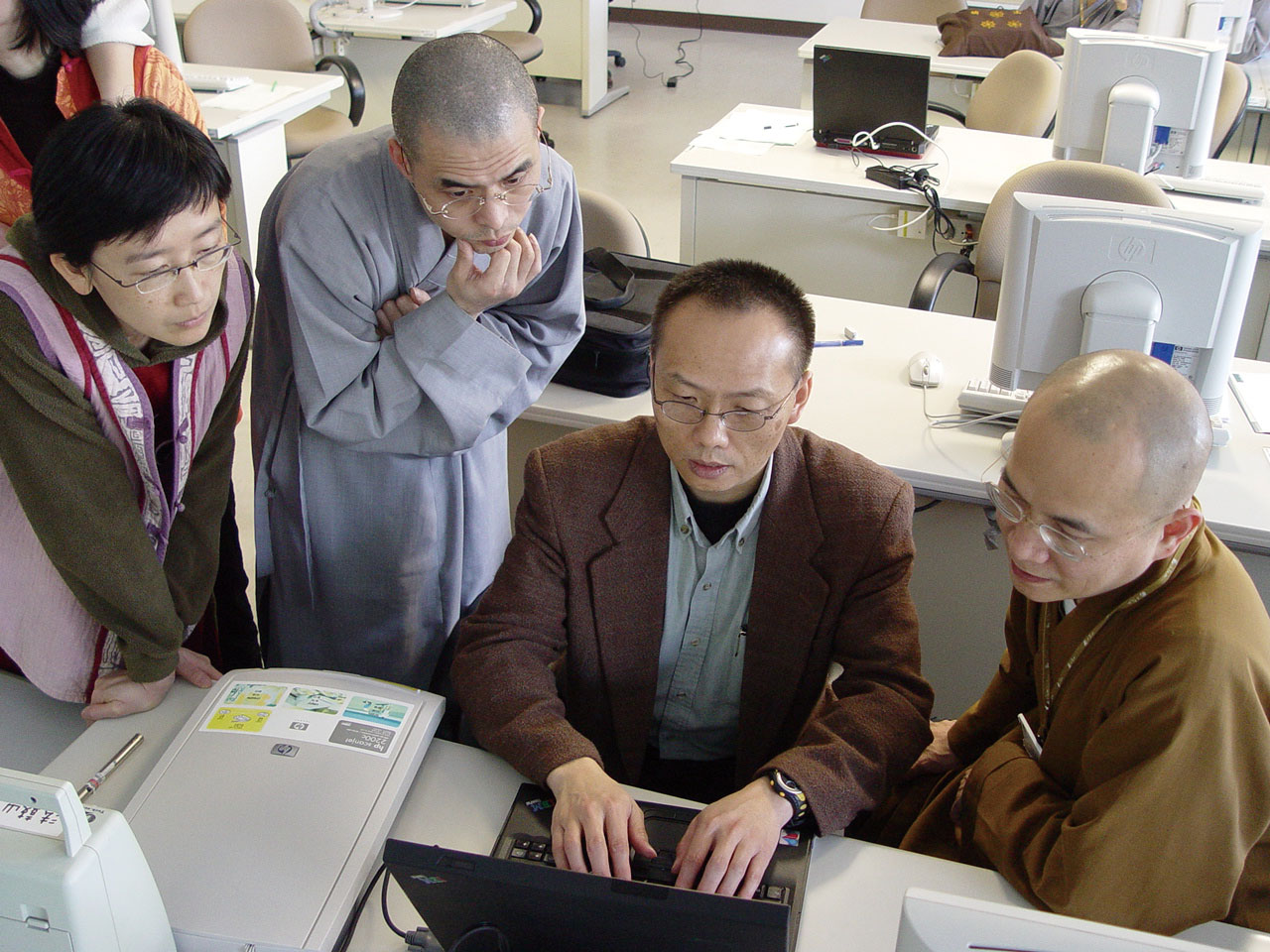
資訊的發展日新月異。
Working on a project.
The Library and Information Center, besides containing in its archive the 55 sets of the Tripitaka written in contemporary Chinese, Sanskrit, and Pali, has also designated a special section housing precious documents and texts, including the over 250 years old palm-leaf manuscripts written in Burmese which, after being catalogued and digitized, have also been turned into compact discs to be distributed online for the convenient use of domestic and overseas scholars. The most distinctive feature of the Center is its ability to mass produce electronic Buddhist scriptures and texts, and on emphasizing the integration of online resources, which enables readers to simultaneously search and retrieve both books and digital data, signifying the integration of virtual space with the real world, or in this case, combining the traditional with the electronic library. Our globalized and modernized Library and Information Center has won the acknowledgement of our visitors. Venerable Ziyan of the Luminary Buddhist Institute pointed out that the establishment of the Library and Information Center represents “the culmination of a truly specialized Buddhist library”. Currently, the Center is also working to expand its service worldwide.
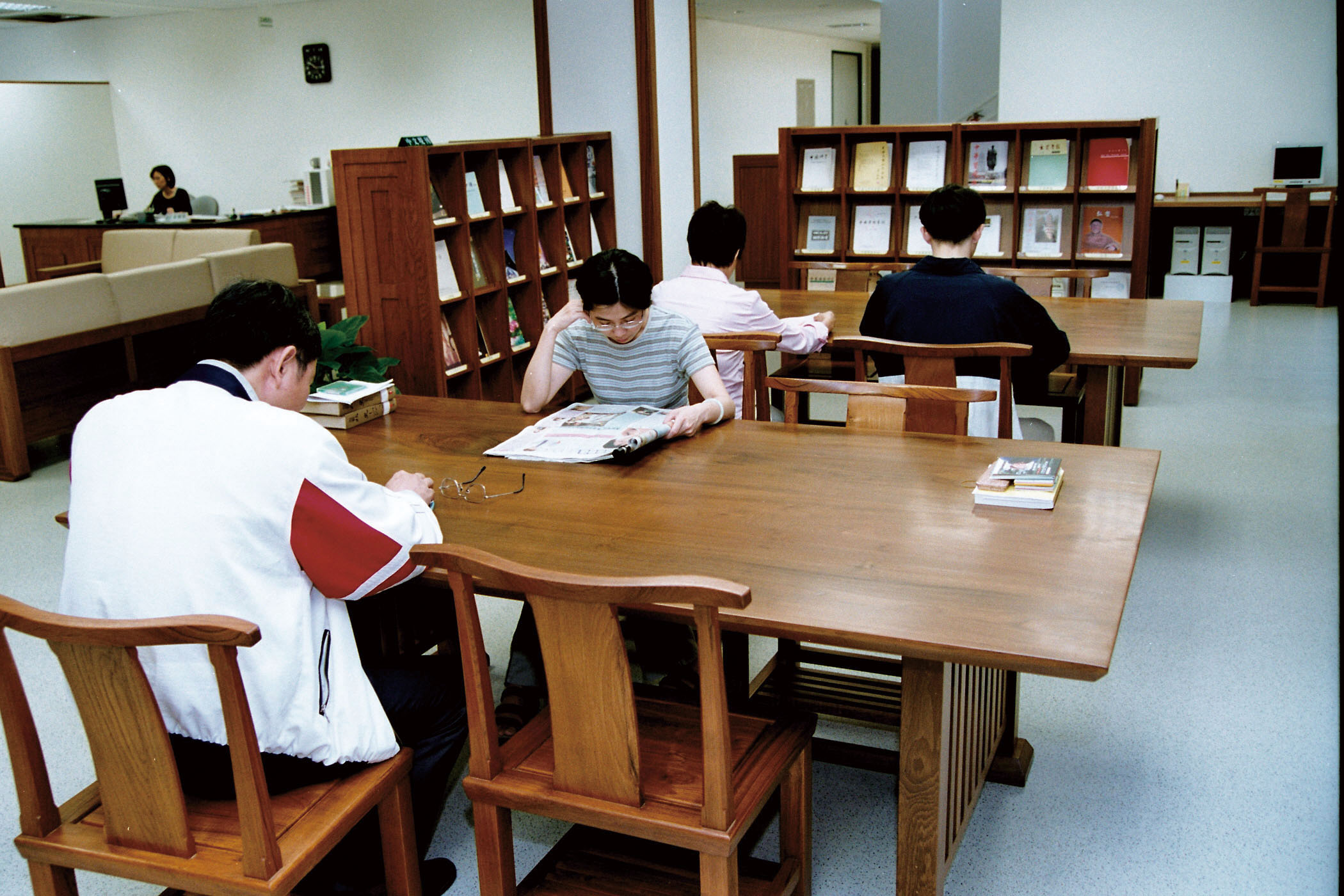
圖資館的資源非常豐富。
Studying in the library.
In addition to putting efforts into the digitization of its archives, CHIBS’ Library and Information Center also places great importance on sharing and exchange of information a vanguard in the digitization of Buddhist data in Taiwan, it is committed to sharing with the world the techniques and know-how of digitization. The most concrete example is the “Digital Library and Museum of Buddhist Studies” website set up in collaboration with the National Taiwan University. This online library, as previously mentioned, holds more than 100,000 Chinese, English, and Japanese bibliographic items, and is currently the largest database of Buddhist studies in the Chinese language in the world, and is also one of the most important search tools for Buddhist researchers worldwide. In addition, the Complete Collection of Master Sheng Yen’s Works published by Dharma Drum Corporation, which contains 100 volumes of works authored by the Master, was also made available on CD owing to the assistance of the Library and Information Center.
The Library and Information Center’s abundant experience in digital database is attributed to the “Information Technology Office”, CHIBS’ IT team. The director, and the entire staff of the “Information Technology Office” have all participated in the largest project of electronic Buddhist texts—the digitization of the Taisho Tripitaka. This pioneering work of digitizing Buddhist canons of up to millions of characters was a valuable experience for all those who were involved in the project. The experience saved the Library and Information Center the trouble of trial and error and in turn helped quicken the pace of development.
In recent years, dialogues between Taiwan and international Buddhist academic circles have become increasingly frequent with many specialists and scholars coming to Taiwan and foreign visiting professors teaching at CHIBS. CHIBS’ Library and Information Center plays a significant role in the promotion of academic research and thus has received considerable attention as many Buddhist specialists and scholars make it one of their vital stops while visiting Taiwan.
Situated in the extraordinary setting of Dharma Drum Mountain, the Library and Information Center is a truly unique place featuring the combination of tradition with the latest technology. Just as the founder, Venerable Master Sheng Yen once stated: “Students will leave once they graduate, but the Library will always be around.” The Center will enable students to benefit from the profound wisdom of the Buddhadharma for generations to come.
The Program of Buddhist Studies
and Information Technology
Established in 2003
I. Origin and establishment of the Program of Buddhist Studies and Information Technology
As we enter the digital age, a significant aspect of the development of today’s academic world is the necessity to incorporate the latest technology in studies of humanities. In order to meet the demand of the information age, CHIBS has been working actively to establish a Program of Buddhist Studies and Information Technology to cultivate talented students equipped with knowledge of Buddhist studies and skills in information technology. Such trainees can make use of the media and technological tools to effectively manage information and documents so as to improve teaching, research, service, and administrative operations in Buddhist communities.
This initiative has created a new climate for Buddhist education at home and overseas. The creation of an environment for life-long study has also opened a new chapter for the history of Buddhism, enabling students’ field of study to be more diversified, and creating a brand-new way for spreading Buddhism.
II. The Program of Buddhist Studies and Information Technology sought approval from the Ministry of Education to establish the Office of Buddhism and Information Technology in 2006
The Office of Buddhism and Information Technology was set up to cultivate monastic teachers who are learned in information technology. The Office aims to train monastics skilled in digital technology to be able to participate in various digitization projects of Buddhist texts and help construct digital Buddhist archives. At the same time, it will foster religious talent capable of incorporating information technology to help spread the Dharma in the information age, as well as those who will devote themselves to academic research in Buddhist studies. More importantly, the Office provides training to teachers in both Buddhist studies and information technology on a long-term basis, so that they can become qualified teachers in Buddhist studies and information technology in various Buddhist organizations, or serve as teachers in universities and colleges. All in all, these endeavors are geared toward fulfilling CHIBS’ objective to “cultivate cultured and academically capable religious teachers with international perspectives who value both theory and practice while embracing both tradition and innovation.”

佛學與資訊的結合。
Learning Buddhist Studies through modern technology.
Conclusion
We have devoted ourselves to various e-Project researches since the establishment of the Information Network Center in February 1998. Globalization is also one of our objectives by means of integrating technology to build a Buddhist research database with comprehensive functions. The Library and Information Center will incorporate resources from the Information Network Center, CBETA, and other units to construct a network of knowledge that combine teaching, research, and administrative functions. As the need for digitization becomes critical in the future, we will also facilitate Dharma Drum Buddhist College with the construction of its website as well as other related digitization efforts.
Buddhist Studies Databases
Established by CHIBS:
【Buddhist Electronic Text】
Chinese Buddhist Electronic Text Association (CBETA)
Website: http://www.cbeta.org
Concordance Tool: http://dev.ddbc.edu.tw/concordance/
Content: The Taishō and the Manji Shinsan Zokuzōkyō editions of the Buddhist Canon, including XML (TEI5) source files
Features: Taisho Tripitaka and Manji Shinsan Zokuzōkyō, with the entire text in digitized form and in accordance with the standard of XML (TEI5) source files.
The new edition of the Chinese Buddhist Electronic Text Association (CBETA) series published in 2009, besides containing volumes 1-55 and 85 of the Taisho Tripitaka, also includes 1-88 of the Manji Zokuzōkyō. Currently CBETA is actively working with other fields to complete the work of updating the new punctuation in the Taisho Tripitaka and to sort out the parts of the Chinese Tripitaka that have not yet been digitized, so as to complete the digitization of the remaining Chinese Buddhist scriptures not found in the Taisho Tripitaka and Manji Zokuzōkyō.
A Multi-lingual Database of the Lotus-Sutra
Website: http://sdp.chibs.edu.tw (IE only)
Content: Digital Comparative Edition of Manuscript Sources for the Lotus Sutra.
Sponsored by the Chiang Ching-kuo Foundation for International Scholarly Exchange, this is a project upon which the renowned scholars, Dr. Toda Hirofumi (who passed away in August 2003) and Professor Mitomo Kenyo of Rissho University collaborated with CHIBS. For this project, the Chinese Lotus Sutra is used as the main text to be compared with other versions of the Lotus Sutra manuscripts before digitization. Furthermore, a Sanskrit manuscript that corresponds with its Chinese counterpart as well as versions in other languages will be produced. A large database will be established online to be used for the reference and application of modern research and teaching.
Yogācārabhūmi Database
Website: http://ybh.chibs.edu.tw (IE only)
http://ybh.ddbc.edu.tw 2008 (IE6+ opera9+ safari Firefox2.0+)
Website (IE only): http://sdp.chibs.edu.tw
Subsidized by the National Science Council, this was a three-year research project (Aug/1/2000-July/31/2003) directed by Venerable Huimin conducted at the Chung-Hwa Institute of Buddhist Studies. The digitization of the Yogācārabhūmi-śāstra as well as its handbook, the various versions of its translation (three sutras and two sastras), the commentary texts, original Sanskrit text, Tibetan translation, etc. was completed as a result. In addition, it has also incorporated functions such as contrasting indexes to include bibliographies, bibliographical explanations, reference books, etc. on its interface.
【Buddhism in Taiwan】
Buddhist Temples in Taiwan
Website: http://dev.ddbc.edu.tw/taiwanbudgis/
Content: Database of Taiwanese Temples and Buddhist sites.
This project will integrate resources from the Digital Database of Taiwanese Buddhist texts, the Digital Museum of Taiwanese Buddhism, and other websites with the Geographical Information System (GIS)—with a special emphasis on the lineage system and distribution of Buddhist temples—to become a platform of geographical information of Buddhist temples in Taiwan, so as to facilitate studies of related topics on the history and geographical information of Buddhism in Taiwan.
The documents cited in the website for this project date from the 17th to the 21st century, to enable us to trace and study the development of Buddhism in Taiwan over several hundred years.
Buddhism in Taiwan of the Ming and Qing Dynasties and During the Japanese Occupation
Website: http://www.chibs.edu.tw/academic/ projects/taiwan/tb/index.htm
Introduction:
The Digital Database of Buddhist Texts in Taiwan project is based on the integration of modern technology and humanities with the hope of establishing a database of Buddhism in Taiwan covering the period from the Ming and Qing dynasties to the present day. Although Buddhism has existed in Taiwan for over three hundred years and has always played an important role in Taiwan’s history and culture, a complete digital database of Taiwanese Buddhist studies has never been constructed either at home or abroad. Therefore, upon the completion of this project, it will not only be the sole digital database of Taiwanese Buddhist studies in the world, but will also be a portal website for domestic and overseas sinologists and Buddhist scholars.
Content: It contains data related to the Buddhism of Taiwan, such as the contents of periodicals, books, records of interviews, documents, photos, and pictures. These documents and data are constructed and managed according to three different time periods: 1. Buddhism in Taiwan during the Kingdom of Zheng of the Ming dynasty and during the Qing dynasty; 2. Buddhism in Taiwan during the Japanese occupation; and 3. Buddhism in Taiwan after the Second World War.
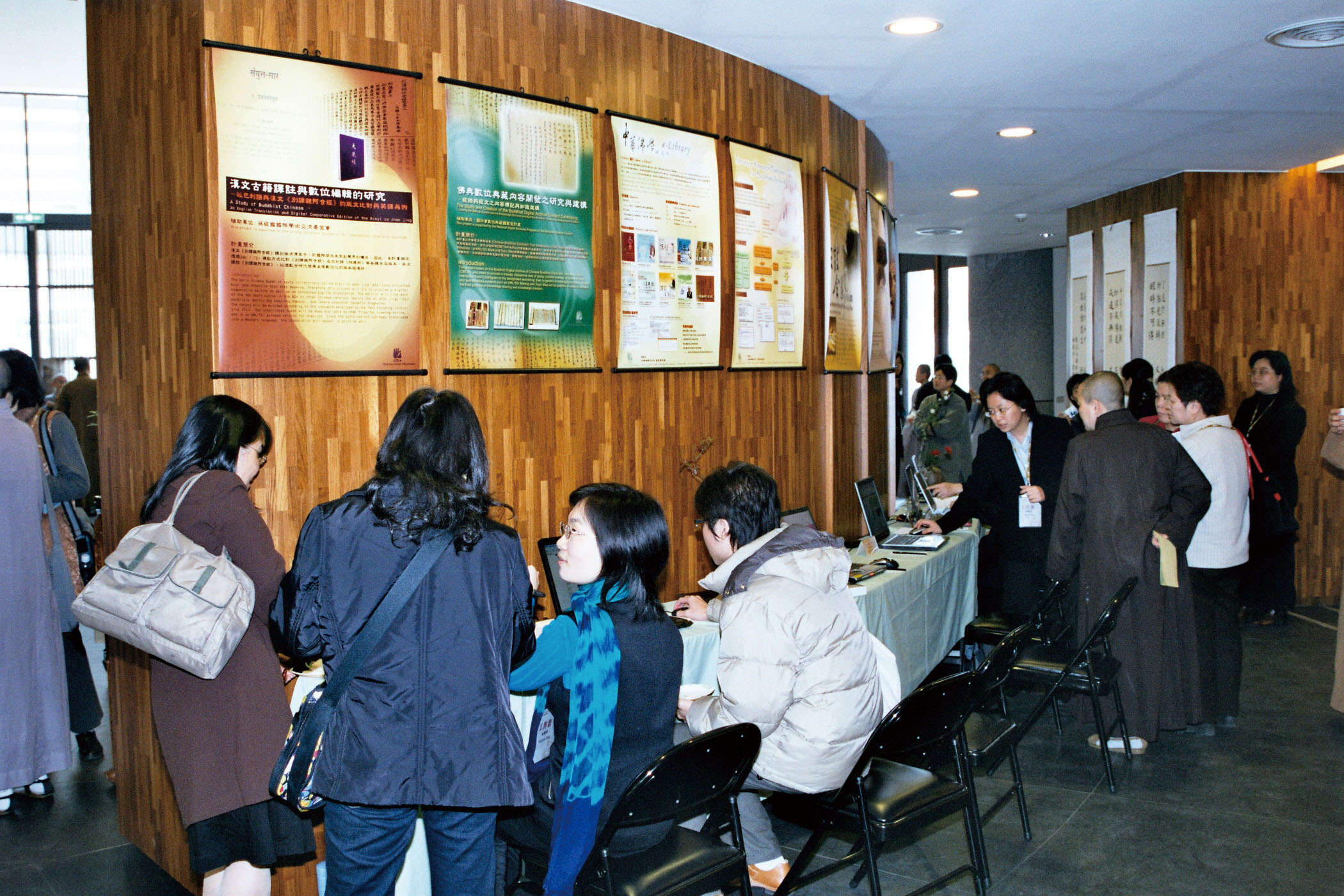
Taiwan Buddhist Digital Museum
Website: http://www.chibs.edu.tw/academic/ projects/taiwan/formosa/index.html
Introduction:
This project draws on CHIBS’ longstanding experience of database construction and archiving in conjunction with the incorporation of digital data of Buddhist texts to build a database pertaining to Buddhism in Taiwan over the past three hundred plus years. It will integrate Internet, multi-media, visual design, script design, content management, techniques of searching and retrieval, etc. to build a global Taiwan Buddhist Digital Museum that’s suitable for all ages. Furthermore, it will include an introduction to Taiwan’s Buddhist temples, cultural and educational organizations, and Buddhist figures, as well as the historical development of Taiwan’s culture and arts. Visitors can also take virtual tours to the monasteries for a realistic pilgrimage experience, thus enabling people around the world to learn about not only the history of Buddhism, but also the ever-vibrant Buddhist culture in Taiwan.
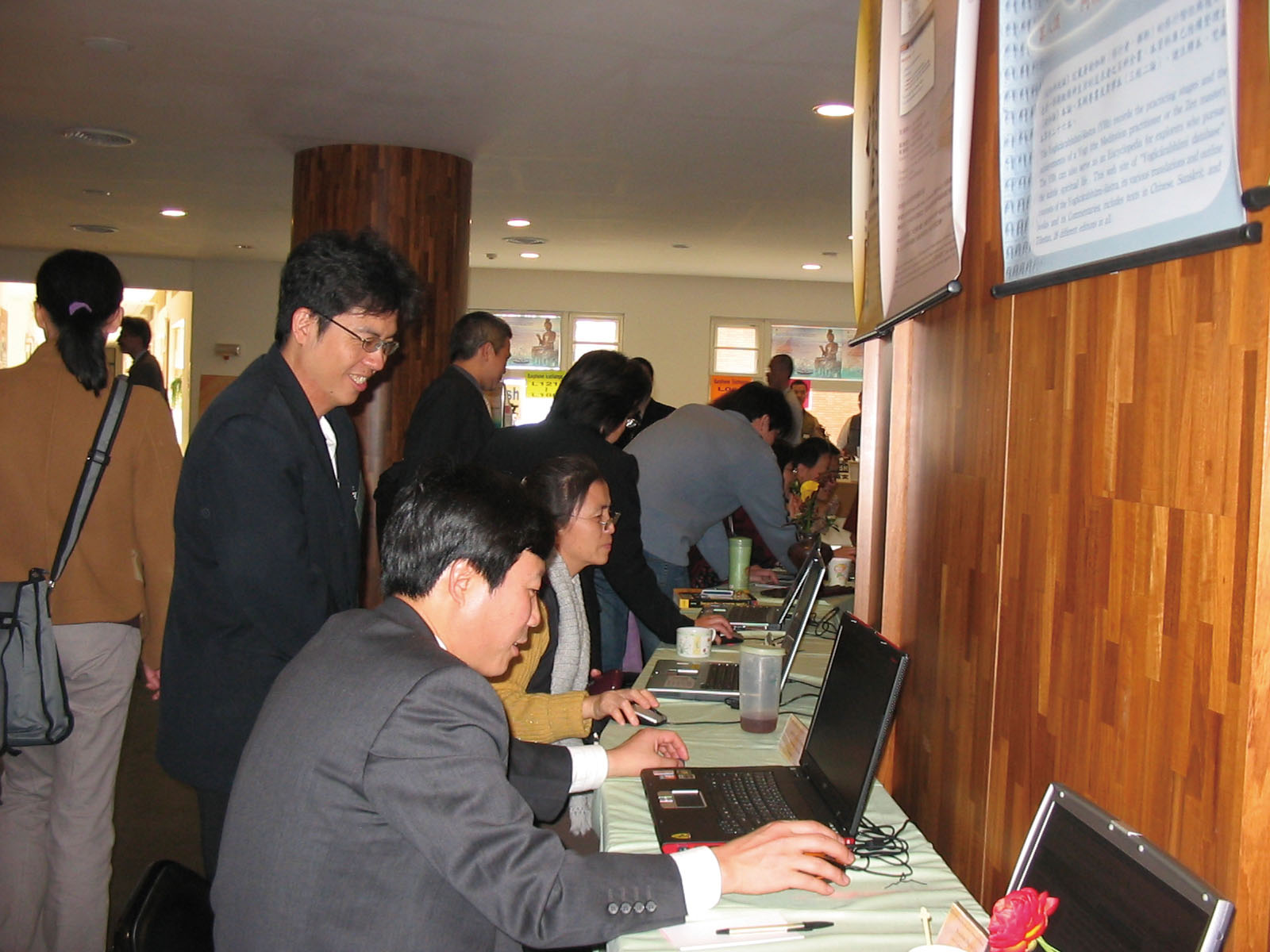
【Catalogs and Publications】
CHIBS Publications
Website: http://www.chibs.edu.tw/publication/c_index.htm
Content: Website of the Chung-Hwa Buddhist Journal and publications of the Dharma Drum Buddhist College.
Features: Important journals and publications on contemporary Buddhist studies written mainly in Chinese.
The Hwa-Kang Buddhist Journal was first published in 1979, and became the Chung-Hwa Buddhist Journal eight years later. The same year it organized an editing committee and invited 50 famous scholars from home and abroad to serve as readers. In addition, it also began to periodically publish on an annual basis significant academic research findings in Chinese, English, Japanese, etc. Papers from mainland China were encouraged and welcomed so as to promote cross-strait academic exchanges.
In light of the establishment of the Dharma Drum Buddhist College and to respond to the globalizing trend in the development of Buddhist studies, the Chung-Hwa Buddhist Journal began publishing English academic papers on Buddhism starting from the 21st issue. Concurrently, the publication of the Dharma Drum Buddhist Journal was also launched, inheriting the tradition of the Chung-Hwa Buddhist Journal and publishing academic papers on Buddhism written in Chinese, English, and Japanese.
Bibliotheca Sacra Birmanica
Website: http://projects.ddbc.edu.tw/palm-leaf/
Content: Catalog of and information on 245 palm-leaf manuscripts in our library collection.
Features: Image file of 245 palm-leaf manuscripts with annotation in the Pali and/or Burmese language, covering history, grammar, and other important subjects.
Introduction:
This Burmese manuscript collection, which has been jointly catalogued by the CHIBS and the Ecole Francaise d’Extreme-Orient, comprises 245 palm-leaf manuscripts. Though they are carved in the script of a Burmese dialect, Pali and Burmese are also used.
Some texts, such as the documents of the Sthaviravadin Tripitaka and their annotation and commentaries, as well as independent Buddhist works, are written only in the Pali language. Some texts are written in the Burmese language, while others are written partly in Pali. The word-for-word translation works of the Pali scriptures and annotations are written in both the Pali and Burmese languages. The earliest text of the collection dates back to 1724 CE, with the most recent from 1930 CE.
【Internet and Applications】
The World of Xuanzang and the Silk Road—
A Digital Museum
Website: http://silkroad.chibs.edu.tw
Introduction:
This digital museum, The World of Xuanzang and the Silk Road, is supervised by the National Taiwan University Graduate Department of Philosophy and consists of the following three subsidiary projects: the research and organization of documents and texts, photos and images, and historical and geographical documents; research and development for interactive models of information visualization; and the systematic research and innovation of information database for the digital museum. The projects are undertaken respectively by the Chung-Hwa Institute of Buddhist Studies, the Arts and Technology Research Center of the Taipei National University of the Arts, and the Graduate Department of Information Engineering at the National Taiwan University.
The website contains The Great Tang Records on the Western Regions, Monkey King, Journey of the Silk Road, cultural arts and artificats, an interactive learning area, document search tools, related websites, and an online dictionary.
【Multimedia Collections】
The Hopkins Tibetan Treasures Multimedia Research Archive
Website: http://haa.ddbc.edu.tw
Content: Recordings of teachings from the Dalai Lama and other eminent Lamas.
Features: One may listen to and download audio files of teachings from the Dalai Lama, search metadata of the installed audio files and access online teaching of the Tibetan language.
Introduction:
This project focuses on archiving the audio files donated to CHIBS by Professor Jeffrey Hopkins (Emeritus, University of Virginia). Its goal is to preserve treasured audio file archives through digitizing the analogical (magnetic) tapes provided by Professor Hopkins and other scholars of Tibetan Buddhism.
Subsidized by the National Science Council and directed by Prof. Magee, this research project which was first launched by CHIBS was handed down to Dharma Drum Buddhist College after one and a half years to continue the work of producing digitized files for research and teaching purposes.
Content: Authentic oral transmission of the various schools of Tibetan Buddhism, and virtually all research topics of Tibetan Buddhism such as Tibetan Buddhist thought, Tibetan history and medicine, and so forth.
【Commemorative Collections】
Digital archive collection to commemorate Venerable Master Dong Chu, Dharma heir of the Linji and Caodong lineages of the Chan School
Website: http://dongchu.ddbc.edu.tw
Features: Containing Master Dongchu’s collected works, chronicle of his life, chronological table, narrative sketch of his conduct and virtues, treasured image files, oral history, etc.
Introduction:
In 2006, Professor Tu, Director of the Library and Information Center, organized the digitization of the eight-volume “Collected Works of Master Dongchu.” After obtaining the consent and authorization from Venerable Guo Yi, editor-in-chief of Dharma Drum Corporation, the task of typing and collation was outsourced beginning in March of 2007. In December of the same year, in commemoration of Venerable Master Dongchu’s 100th birthday, the Great Compassion Water and Land Dharma Service was held at the DDM World Center for Buddhist Education with the hope that with the merit generated from the prayers of the faithful, the Buddhadharma would be spread far and wide through the concerted effort of the monastic and lay followers.
The special Digital Archive Collection of Venerable Master Dong Chu, a Dharma Heir of the Linji and Caodong Lineages of Chan School, was the collaborative work of CHIBS and Dharma Drum Buddhist College.
During Library Week in 2006, the Library and Information Center planned a special Documentary Exhibition in Commemoration of the 30th Anniversary on the Passing of Venerable Master Dong Chu and the 50th Anniversary of the Promotion of the Tripitaka for Buddhism in Taiwan. Venerable Guo Jian, Deputy Director of the Library and Information Center, and the staff of the Library Office collected precious photos and manuscripts for the event, conducted interviews to gather multiple records of oral history, and combined them with Venerable Master Dong Chu’s works to be included in the CD.
The Collected Works of
Venerable Master Sheng Yen
Website: http://www.chibs.edu.tw/mddc
Introduction:
In 1999, to celebrate Venerable Master Sheng Yen’s 70th birthday, Dharma Drum Corporation re-edited The Collected Works of Venerable Master Sheng Yen into 9 albums containing 70 volumes. The Collected Works of Venerable Master Sheng Yen has been widely collected by the general public, schools, and libraries worldwide, gaining wide readership.
In 2001, The Collected Works of Venerable Master Sheng Yen was digitized into compact discs, offering more search functions, making data research and collection a much easier task to save users considerable time and energy. We believe that even more scholars will benefit from the The Collected Works of Venerable Master Sheng Yen CD.
Professor Lee Chih-fu’s
Commemoration CD
This archive is distributed only on CD-ROM. Please e-mail us for more information.
Content: academic works and photos of Professor Lee Chih-fu.
Features: Containing the records of Prof. Lee Chih-fu’s various contributions to the academic and documentary studies and to the teaching field, as well as sketches from his life at CHIBS.
Introduction:
For more than twenty years, Professor Lee Chih-fu, Director of the Chung-Hwa Institute of Buddhist Studies, has not only been responsible for the institute’s administrative affairs, but has also devoted himself to the academic and documentary study of Buddhism, and has contributed to the fostering of numerous outstanding Buddhist scholars. We will be publishing a CD album documenting his academic accomplishments and contributions to CHIBS. The CD will also feature interviews of his students and friends, cultural artifacts and photos from various periods of his life to express our gratitude to Director Lee for his long-term devotion and contribution to CHIBS.
The CD contains two major components:
1. Director Lee’s contributions to CHIBS in the past twenty plus years.
2. Director Lee’s accomplishments in academic and documentary studies.
The Collection of Prof.
Mukherjee’s Articles in Honor of His Visit to Taiwan
Website: http://www.chibs.edu.tw/mukherjee
Notice: This archive is also distributed on CD-ROM. Please e-mail us.
Features: Professor Mukherjee’s activities, academic works, recitation of Sanskrit scriptures, precious photos, etc., from his visit to Taiwan.
Content:
The archive contains an account of the causes and conditions of Prof. Mukherjee’s visit to Taiwan, and an introduction to his background and past activities. It also features a total of nine thesis papers he published during his visit to Taiwan from 1993 to 2000, the lists of all his works, and his out-of-print doctoral dissertation. In addition, it includes audio files of the professor’s recitation of Sanskrit scriptures such as the Heart Sutra and photos of his life in Taiwan.










